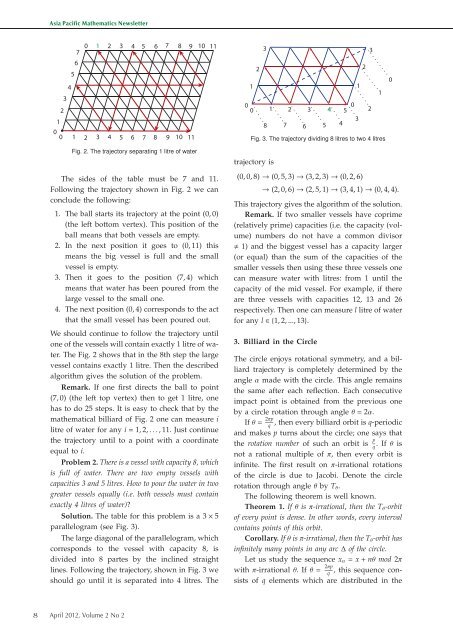Mathematics Newsletter
Mathematics Newsletter
Mathematics Newsletter
Create successful ePaper yourself
Turn your PDF publications into a flip-book with our unique Google optimized e-Paper software.
8<br />
Asia Pacific <strong>Mathematics</strong> <strong>Newsletter</strong><br />
33<br />
22<br />
55<br />
44<br />
7<br />
6<br />
0 1 2 3 4 5 6 0<br />
7<br />
6<br />
2 3<br />
7 8 9 10 11<br />
1 4 5 6 7 8 9 10 11<br />
11<br />
00<br />
00 11 2 3 4 5 6 7 8 9 10 11 11<br />
Fig. 2. The trajectory separating 1 litre of water<br />
The sides of the table must be 7 and 11.<br />
Following the trajectory shown in Fig. 2 we can<br />
conclude the following:<br />
1. The ball starts its trajectory at the point (0, 0)<br />
(the left bottom vertex). This position of the<br />
ball means that both vessels are empty.<br />
2. In the next position it goes to (0, 11) this<br />
means the big vessel is full and the small<br />
vessel is empty.<br />
3. Then it goes to the position (7, 4) which<br />
means that water has been poured from the<br />
large vessel to the small one.<br />
4. The next position (0, 4) corresponds to the act<br />
that the small vessel has been poured out.<br />
We should continue to follow the trajectory until<br />
one of the vessels will contain exactly 1 litre of water.<br />
The Fig. 2 shows that in the 8th step the large<br />
vessel contains exactly 1 litre. Then the described<br />
algorithm gives the solution of the problem.<br />
Remark. If one first directs the ball to point<br />
(7, 0) (the left top vertex) then to get 1 litre, one<br />
has to do 25 steps. It is easy to check that by the<br />
mathematical billiard of Fig. 2 one can measure i<br />
litre of water for any i = 1, 2, ..., 11. Just continue<br />
the trajectory until to a point with a coordinate<br />
equal to i.<br />
Problem 2. There is a vessel with capacity 8, which<br />
is full of water. There are two empty vessels with<br />
capacities 3 and 5 litres. How to pour the water in two<br />
greater vessels equally (i.e. both vessels must contain<br />
exactly 4 litres of water)?<br />
Solution. The table for this problem is a 3 × 5<br />
parallelogram (see Fig. 3).<br />
The large diagonal of the parallelogram, which<br />
corresponds to the vessel with capacity 8, is<br />
divided into 8 partes by the inclined straight<br />
lines. Following the trajectory, shown in Fig. 3 we<br />
should go until it is separated into 4 litres. The<br />
April 2012, Volume 2 No 2<br />
1<br />
2<br />
3<br />
0<br />
0<br />
0 0 1 2 3 5 0<br />
0 1 2 3 4 5<br />
3<br />
8 7 6 5 4 3<br />
8 7 6 5 4<br />
Fig. 3. The trajectory dividing 8 litres to two 4 litres<br />
trajectory is<br />
(0, 0, 8) → (0, 5, 3) → (3, 2, 3) → (0, 2, 6)<br />
→ (2, 0, 6) → (2, 5, 1) → (3, 4, 1) → (0, 4, 4).<br />
This trajectory gives the algorithm of the solution.<br />
Remark. If two smaller vessels have coprime<br />
(relatively prime) capacities (i.e. the capacity (volume)<br />
numbers do not have a common divisor<br />
� 1) and the biggest vessel has a capacity larger<br />
(or equal) than the sum of the capacities of the<br />
smaller vessels then using these three vessels one<br />
can measure water with litres: from 1 until the<br />
capacity of the mid vessel. For example, if there<br />
are three vessels with capacities 12, 13 and 26<br />
respectively. Then one can measure l litre of water<br />
for any l ∈{1, 2, ..., 13}.<br />
3. Billiard in the Circle<br />
The circle enjoys rotational symmetry, and a billiard<br />
trajectory is completely determined by the<br />
angle α made with the circle. This angle remains<br />
the same after each reflection. Each consecutive<br />
impact point is obtained from the previous one<br />
by a circle rotation through angle θ = 2α.<br />
If θ = 2πp<br />
q , then every billiard orbit is q-periodic<br />
and makes p turns about the circle; one says that<br />
the rotation number of such an orbit is p<br />
q . If θ is<br />
not a rational multiple of π, then every orbit is<br />
infinite. The first result on π-irrational rotations<br />
of the circle is due to Jacobi. Denote the circle<br />
rotation through angle θ by Tθ.<br />
The following theorem is well known.<br />
Theorem 1. If θ is π-irrational, then the Tθ-orbit<br />
of every point is dense. In other words, every interval<br />
contains points of this orbit.<br />
Corollary. If θ is π-irrational, then the Tθ-orbit has<br />
infinitely many points in any arc ∆ of the circle.<br />
Let us study the sequence xn = x + nθ mod 2π<br />
with π-irrational θ. If θ = 2πp<br />
q , this sequence consists<br />
of q elements which are distributed in the<br />
1<br />
2<br />
3<br />
2<br />
1<br />
0<br />
3


